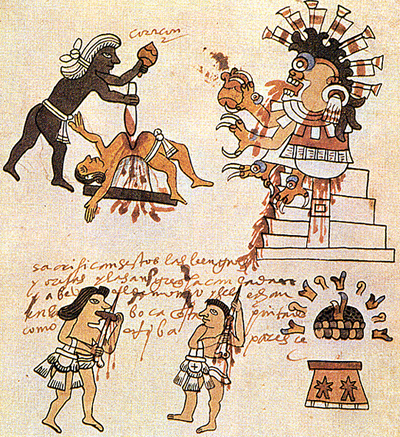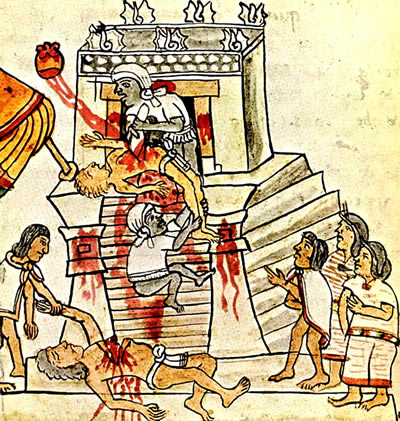World History
Although some maintain that the notion that the Aztecs (Mexica) practiced human sacrifice is a myth that originated with the Spanish conquistadores to justify and legitimate their conquests, in fact, abundant evidence demonstrates that the Aztec state, like many other pre-Columbian Mesoamerican and Andean polities, regularly practiced ritual human sacrifice.
The evidence also shows that the Aztecs institutionalized this practice, elevating it to a high art form, the state’s most important public spectacle, and a key state function essential to the well-being of the cosmos.
This evidence includes scores of Spanish and native accounts composed during and after the conquest of Mexico, along with abundant archaeological and textual artifacts that predate the Spanish invasion.
The religious and cultural beliefs inspiring Aztec ritual human sacrifice had deep roots in Mesoamerican society and culture. Many pre-Columbian polities in the Americas are known to have ritually sacrificed human beings to their gods.
These included many Maya kingdoms and city-states, Monte Albán and subsequent Zapotec polities, Teotihuacán, the Toltecs, and others. Such practices were rooted in a pan-Mesoamerican corpus of beliefs concerning the spiritual power of human blood, and the everyday intervention of the gods in human affairs.
States transformed these broad cultural understandings into state ideologies and spectacles. Ruling groups portrayed public offerings of human blood as payment of a debt owed to the gods.
By propitiating the gods with the most valuable substance in the universe—human blood—states terrorized foes and depicted themselves securing a larger social and cosmic good. Public and private bloodletting rituals in the service of the gods were common across Mesoamerica, and ritual human sacrifice was the most extreme form of bloodletting.
The Aztecs took the practice to an extreme, sacrificing people on diverse occasions in propitiation of many divine beings. Of the 18 ceremonial events that occurred during each of the 18 months of the Aztec solar year, eight included ritual human sacrifice.
These included the ceremony of Quecholli (“Precious Feather,†October 31–November 9), in which priests ritually slew and sacrificed captives dressed as deer, and the ceremony of Atl Caualo (“Ceasing of Water,†February 13–March 4), in which infants and children were publicly marched in groups before being sacrificed. The gruesome sacrifice involved four priests holding the victim down on top of a large stone for another priest to cut open in order to remove the heart.

By ritual preparation and transformation, the victim was depicted as becoming the god to whom he or she would be sacrificed. There were many variations on these general themes. The most frequently propitiated divine entity was Huitzilopochtli, the god of the Sun and war, particularly at the end of each 52-year Aztec century. Without such offerings, the state claimed, the Sun would cease to rise and the universe would come to an end.
After the Aztec Triple Alliance of 1428 joined together Tenochtitlán, Texcoco, and Tlacopán, the practice of human sacrifice was institutionalized at the highest levels of the Aztec state. Major events such as victory in war, inauguration of a new ruler, or dedication of an important public structure became occasions for large-scale human sacrifice.
The most extensive such instance occurred in 1487 with the dedication of the Temple of Huitzilopochtli in Tenochtitlán, in which an estimated 20,000 people were ritually sacrificed over four days. The Aztecs also initiated prearranged wars with neighboring polities—ritualized battles called the “Flowery Warsâ€â€”in large part to secure sacrificial victims.
In its meteoric rise to domination, the Aztec state made such practices integral to state ideology and imperial ambitions. Ritual human sacrifice displayed the Aztec state’s awesome political and religious power, terrorized its enemies, worked as a cohesive ideological force among its subjects, and generated animosities against its rule among subordinate states that the Spanish later exploited in the conquest of Mexico.
- Postclassic Period Of Mesoamerica
Postclassic Period of Mesoamerica Postclassic Mesoamerica (900–1500 c.e.) encompassed four principal geographic regions: the Maya zones to the south and east; the central highlands, centered on the Basin of Mexico; the Zapotecs of the Oaxaca Valley;...
- Quetzalcoatl
Quetzalcoatl Quetzalcoatl evokes one of the great tales of Middle American (Mesoamerican) mythology. In Nahuatl, the language of the Aztecs of Mexico, the name Quetzalcoatl can be translated as “feathered serpent.†There is in fact a quetzal...
- Aztecs (mexica)
Aztecs (Mexica) Because the Aztec elite continually retold their own history to accord with contemporaneous political and religious concerns, the origins of the Aztec Empire are shrouded in myth and legend. The consensus view among scholars is that the...
- Children Of Llullaillaco Sacrificed With Alcohol
CNN has an article up titled Mummy of girl sacrificed by Incans prompts gasps. It details a display of a mummy of a 15 year old girl in Salta, Argentina who was killed 500 years ago in a sacrifice. The mummy is well preserved and the features on the girl...
- The Aztecs
The Aztecs - A Spanish and English presentation about the Aztec Empire and its fall, and the everyday life and culture of its people. Also provides a selection of games and quizzes, images, and maps. From the site: Around 700 years ago ...........
World History
Human Sacrifice and the Aztecs
 |
| Human Sacrifice and the Aztecs |
Although some maintain that the notion that the Aztecs (Mexica) practiced human sacrifice is a myth that originated with the Spanish conquistadores to justify and legitimate their conquests, in fact, abundant evidence demonstrates that the Aztec state, like many other pre-Columbian Mesoamerican and Andean polities, regularly practiced ritual human sacrifice.
The evidence also shows that the Aztecs institutionalized this practice, elevating it to a high art form, the state’s most important public spectacle, and a key state function essential to the well-being of the cosmos.
This evidence includes scores of Spanish and native accounts composed during and after the conquest of Mexico, along with abundant archaeological and textual artifacts that predate the Spanish invasion.
  |   |
The religious and cultural beliefs inspiring Aztec ritual human sacrifice had deep roots in Mesoamerican society and culture. Many pre-Columbian polities in the Americas are known to have ritually sacrificed human beings to their gods.
These included many Maya kingdoms and city-states, Monte Albán and subsequent Zapotec polities, Teotihuacán, the Toltecs, and others. Such practices were rooted in a pan-Mesoamerican corpus of beliefs concerning the spiritual power of human blood, and the everyday intervention of the gods in human affairs.
States transformed these broad cultural understandings into state ideologies and spectacles. Ruling groups portrayed public offerings of human blood as payment of a debt owed to the gods.
By propitiating the gods with the most valuable substance in the universe—human blood—states terrorized foes and depicted themselves securing a larger social and cosmic good. Public and private bloodletting rituals in the service of the gods were common across Mesoamerica, and ritual human sacrifice was the most extreme form of bloodletting.
The Aztecs took the practice to an extreme, sacrificing people on diverse occasions in propitiation of many divine beings. Of the 18 ceremonial events that occurred during each of the 18 months of the Aztec solar year, eight included ritual human sacrifice.
These included the ceremony of Quecholli (“Precious Feather,†October 31–November 9), in which priests ritually slew and sacrificed captives dressed as deer, and the ceremony of Atl Caualo (“Ceasing of Water,†February 13–March 4), in which infants and children were publicly marched in groups before being sacrificed. The gruesome sacrifice involved four priests holding the victim down on top of a large stone for another priest to cut open in order to remove the heart.

By ritual preparation and transformation, the victim was depicted as becoming the god to whom he or she would be sacrificed. There were many variations on these general themes. The most frequently propitiated divine entity was Huitzilopochtli, the god of the Sun and war, particularly at the end of each 52-year Aztec century. Without such offerings, the state claimed, the Sun would cease to rise and the universe would come to an end.
After the Aztec Triple Alliance of 1428 joined together Tenochtitlán, Texcoco, and Tlacopán, the practice of human sacrifice was institutionalized at the highest levels of the Aztec state. Major events such as victory in war, inauguration of a new ruler, or dedication of an important public structure became occasions for large-scale human sacrifice.
The most extensive such instance occurred in 1487 with the dedication of the Temple of Huitzilopochtli in Tenochtitlán, in which an estimated 20,000 people were ritually sacrificed over four days. The Aztecs also initiated prearranged wars with neighboring polities—ritualized battles called the “Flowery Warsâ€â€”in large part to secure sacrificial victims.
In its meteoric rise to domination, the Aztec state made such practices integral to state ideology and imperial ambitions. Ritual human sacrifice displayed the Aztec state’s awesome political and religious power, terrorized its enemies, worked as a cohesive ideological force among its subjects, and generated animosities against its rule among subordinate states that the Spanish later exploited in the conquest of Mexico.
- Postclassic Period Of Mesoamerica
Postclassic Period of Mesoamerica Postclassic Mesoamerica (900–1500 c.e.) encompassed four principal geographic regions: the Maya zones to the south and east; the central highlands, centered on the Basin of Mexico; the Zapotecs of the Oaxaca Valley;...
- Quetzalcoatl
Quetzalcoatl Quetzalcoatl evokes one of the great tales of Middle American (Mesoamerican) mythology. In Nahuatl, the language of the Aztecs of Mexico, the name Quetzalcoatl can be translated as “feathered serpent.†There is in fact a quetzal...
- Aztecs (mexica)
Aztecs (Mexica) Because the Aztec elite continually retold their own history to accord with contemporaneous political and religious concerns, the origins of the Aztec Empire are shrouded in myth and legend. The consensus view among scholars is that the...
- Children Of Llullaillaco Sacrificed With Alcohol
CNN has an article up titled Mummy of girl sacrificed by Incans prompts gasps. It details a display of a mummy of a 15 year old girl in Salta, Argentina who was killed 500 years ago in a sacrifice. The mummy is well preserved and the features on the girl...
- The Aztecs
The Aztecs - A Spanish and English presentation about the Aztec Empire and its fall, and the everyday life and culture of its people. Also provides a selection of games and quizzes, images, and maps. From the site: Around 700 years ago ...........
